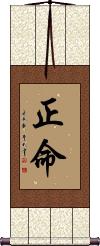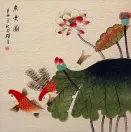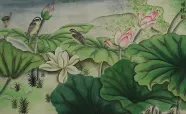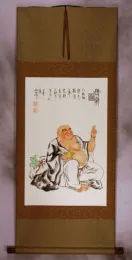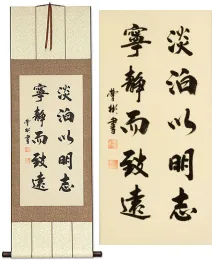Many custom options...
And formats...

Right Living in Chinese / Japanese...
Buy a Right Living calligraphy wall scroll here!
5. Right Living / Right Livelihood / Perfect Livelihood
Samyag Ajiva / Samma Ajiva
正命 (right living) is one of the Noble Eightfold Paths of Buddhism.
Right Living, along with Right Speech and Right Action, constitute the path to Virtue.
Right Living means that a Buddhist should only take a job or pursue a career in a field that does no harm. Buddhists should not work in the arms trade, as pimps or in the field of prostitution, as a butcher or in a shop that kills or sells meat, in a laboratory that does animal research, or in any other business that involves scheming or unethical behavior.
Another definition: Avoidance of professions that are harmful to sentient beings, such as slaughterer, hunter, dealer in weaponry or narcotics, etc.
This term is exclusively used by devout Buddhists. It is not a common term, and is remains an unknown concept to most Japanese and Chinese people.
See Also: Buddhism | Enlightenment | Noble Eightfold Path
This in-stock artwork might be what you are looking for, and ships right away...
Gallery Price: $101.00
Your Price: $55.88
Gallery Price: $101.00
Your Price: $55.88
Gallery Price: $300.00
Your Price: $128.88
Gallery Price: $286.00
Your Price: $158.88
Gallery Price: $198.00
Your Price: $109.88
Not the results for right living that you were looking for?
Below are some entries from our dictionary that may match your right living search...
| Characters If shown, 2nd row is Simp. Chinese |
Pronunciation Romanization |
Simple Dictionary Definition |
正命 see styles |
zhèng mìng zheng4 ming4 cheng ming shoumyou / shomyo しょうみょう |
More info & calligraphy: 5. Right Living / Right Livelihood / Perfect Livelihoodsamyagājīva, the fifth of the 八正道, right livelihood, right life; 'abstaining from any of the forbidden modes of living. ' 正因 The true or direct cause, as compared with 緣因 a contributory cause. |
乞食 see styles |
qǐ shí qi3 shi2 ch`i shih chi shih kojiki(p); kotsujiki(ok) こじき(P); こつじき(ok) |
to beg for food (1) (sensitive word) beggar; (n,vs,vi) (2) begging To beg for food, one of the twelve dhūtas prescribing outward conduct of the monk; mendicancy is the 正命 right livelihood of a monk, to work for a living is 邪命 an improper life: mendicancy keeps a monk humble, frees him from the cares of life, and offers the donors a field of blessedness; but he may not ask for food. |
勝手 see styles |
katsute かつて |
(noun or adjectival noun) (1) one's own convenience; one's way; selfishness; (2) surroundings; environment; way of doing things; (3) convenience; ease of use; (4) financial circumstances; living; livelihood; (5) (See 台所・1) kitchen; (6) right hand (in archery); hand that pulls the bowstring; (prefix noun) (7) unauthorised (e.g. phone app, WWW site); unofficial; (surname) Katsute |
安堵 see styles |
ando あんど |
(n,vs,vi) (1) relief; reassurance; (noun, transitive verb) (2) (hist) (See 本領安堵) recognition of right to land ownership (by the shogunate, a feudal lord, etc.); (n,vs,vi) (3) (archaism) (orig. meaning) living safely surrounded by walls; (place-name, surname) Ando |
三佛性 see styles |
sān fó xìng san1 fo2 xing4 san fo hsing san busshō |
The three kinds of Buddha-nature: (1) 自性住佛性 the Buddha-nature which is in all living beings, even those in the three evil paths (gati). (2) 引出佛性 the Buddha-nature developed by the right discipline. (3) 至得果佛性 the final or perfected Buddha-nature resulting from the development of the original potentiality. |
五種藏 五种藏 see styles |
wǔ zhǒng zàng wu3 zhong3 zang4 wu chung tsang goshu zō |
The five 'stores', or the five differentiations of the one Buddha-nature; (1) 如來藏 the Tathāgata-nature, which is the fundamental universal nature possessed by all the living: (2) 正法藏 the source or treasury of all right laws and virtues: (3) 法身藏 the storehouse of the dharmakāya obtained by all saints: (4) 出世藏 the eternal spiritual nature, free from earthly errors; (5) 自性淸淨藏 the storehouse of the pure Buddha-nature. Another similar group is 如來藏, 法界藏, 法身藏, 出世間上上藏, and 自性淸淨藏. |
大梵天 see styles |
dà fàn tiān da4 fan4 tian1 ta fan t`ien ta fan tien Daibon ten |
Mahābrahman; Brahma; 跋羅吸摩; 波羅賀磨; 梵覽摩; 梵天王; 梵王; 梵. Eitel says: "The first person of the Brahminical Trimūrti, adopted by Buddhism, but placed in an inferior position, being looked upon not as Creator, but as a transitory devatā whom every Buddhistic saint surpasses on obtaining bodhi. Notwithstanding this, the Saddharma-puṇḍarīka calls Brahma 'the father of all living beings'" 一切衆生之父. Mahābrahman is the unborn or uncreated ruler over all, especially according to Buddhism over all the heavens of form, i.e. of mortality. He rules over these heavens, which are of threefold form: (a) Brahma (lord), (b) Brahma-purohitas (ministers), and (c) Brahma-pāriṣadyāh (people). His heavens are also known as the middle dhyāna heavens, i.e. between the first and second dhyānas. He is often represented on the right of the Buddha. According to Chinese accounts the Hindus speak of him (1) as born of Nārāyaṇa, from Brahma's mouth sprang the brahmans, from his arms the kṣatriyas, from his thighs the vaiśyas, and from his feet the śūdras; (2) as born from Viṣṇu; (3) as a trimūrti, evidently that of Brahma, Viṣṇu, and Śiva, but Buddhists define Mahābrahma's dharmakāya as Maheśvara (Śiva), his saṃbhogakāya as Nārāyaṇa, and his nirmāṇakāya as Brahmā. He is depicted as riding on a swan, or drawn by swans. |
景観権 see styles |
keikanken / kekanken けいかんけん |
right to a view; right to enjoy scenery from one's living space |
那羅延 那罗延 see styles |
nà luó yán na4 luo2 yan2 na lo yen Naraen |
(那羅延那); 那羅野拏 Nārāyaṇa, 'son of Nara or the original man, patronymic of the personified Purusha or first living being, author of the Purusha hymn,' M. W. He is also identified with Brahmā, Viṣṇu, or Kṛṣṇa; intp. by 人生本 the originator of human life; 堅固 firm and stable; 力士 or 天界力士 hero of divine power; and 金剛 vajra; the term is used adjectivally with the meaning of manly and strong. Nārāyaṇa is represented with three faces, of greenish-yellow colour, right hand with a wheel, riding a garuḍa-bird. |
阿彌陀 阿弥陀 see styles |
ā mí tuó a1 mi2 tuo2 a mi t`o a mi to Amida あみだ |
(out-dated kanji) (1) (Buddhist term) Amitabha (Buddha); Amida; (2) (kana only) (abbreviation) ghostleg lottery; ladder lottery; lottery in which participants trace a line across a lattice pattern to determine the winner; (3) (kana only) (abbreviation) wearing a hat pushed back on one's head (阿彌) amita, boundless, infinite; tr. by 無量 immeasurable. The Buddha of infinite qualities, known as 阿彌陀婆 (or 阿彌陀佛) Amitābha, tr. 無量光 boundless light; 阿彌陀廋斯Amitāyus, tr. 無量壽 boundless age, or life; and among the esoteric sects Amṛta 甘露 (甘露王) sweet-dew (king). An imaginary being unknown to ancient Buddhism, possibly of Persian or Iranian origin, who has eclipsed the historical Buddha in becoming the most popular divinity in the Mahāyāna pantheon. His name indicates an idealization rather than an historic personality, the idea of eternal light and life. The origin and date of the concept are unknown, but he has always been associated with the west, where in his Paradise, Suikhāvatī, the Western Pure Land, he receives to unbounded happiness all who call upon his name (cf. the Pure Lands 淨土 of Maitreya and Akṣobhya). This is consequent on his forty-eight vows, especially the eighteenth, in which he vows to refuse Buddhahood until he has saved all living beings to his Paradise, except those who had committed the five unpardonable sins, or were guilty of blasphemy against the Faith. While his Paradise is theoretically only a stage on the way to rebirth in the final joys of nirvana, it is popularly considered as the final resting-place of those who cry na-mo a-mi-to-fo, or blessed be, or adoration to, Amita Buddha. The 淨土 Pure-land (Jap. Jōdo) sect is especially devoted to this cult, which arises chiefly out of the Sukhāvatīvyūha, but Amita is referred to in many other texts and recognized, with differing interpretations and emphasis, by the other sects. Eitel attributes the first preaching of the dogma to 'a priest from Tokhara' in A. D.147, and says that Faxian and Xuanzang make no mention of the cult. But the Chinese pilgrim 慧日Huiri says he found it prevalent in India 702-719. The first translation of the Amitāyus Sutra, circa A.D. 223-253, had disappeared when the Kaiyuan catalogue was compiled A.D. 730. The eighteenth vow occurs in the tr. by Dharmarakṣa A.D. 308. With Amita is closely associated Avalokiteśvara, who is also considered as his incarnation, and appears crowned with, or bearing the image of Amita. In the trinity of Amita, Avalokiteśvara appears on his left and Mahāsthāmaprāpta on his right. Another group, of five, includes Kṣitigarbha and Nāgārjuna, the latter counted as the second patriarch of the Pure Land sect. One who calls on the name of Amitābha is styled 阿彌陀聖 a saint of Amitābha. Amitābha is one of the Five 'dhyāni buddhas' 五佛, q.v. He has many titles, amongst which are the following twelve relating to him as Buddha of light, also his title of eternal life: 無量光佛Buddha of boundless light; 無邊光佛 Buddha of unlimited light; 無礙光佛 Buddha of irresistible light; 無對光佛 Buddha of incomparable light; 燄王光佛 Buddha of yama or flame-king light; 淸淨光佛 Buddha of pure light; 歡喜光佛 Buddha of joyous light; 智慧光佛 Buddha of wisdom light; 不斷光佛 Buddha of unending light; 難思光佛 Buddha of inconceivable light; 無稱光佛Buddha of indescribable light; 超日月光佛 Buddha of light surpassing that of sun and moon; 無量壽 Buddha of boundless age. As buddha he has, of course, all the attributes of a buddha, including the trikāya, or 法報化身, about which in re Amita there are differences of opinion in the various schools. His esoteric germ-letter is hrīḥ, and he has specific manual-signs. Cf. 阿彌陀經, of which with commentaries there are numerous editions. |
Variations: |
ando あんど |
(n,vs,vi) (1) relief; reassurance; (noun, transitive verb) (2) (hist) (See 本領安堵) recognition of right to land ownership (by the shogunate, a feudal lord, etc.); (n,vs,vi) (3) (archaism) (orig. meaning) living safely surrounded by walls |
The following table may be helpful for those studying Chinese or Japanese...
| Title | Characters | Romaji (Romanized Japanese) | Various forms of Romanized Chinese | |
| 5. Right Living Right Livelihood Perfect Livelihood | 正命 | sei myou / seimyou / sei myo | zhèng mìng zheng4 ming4 zheng ming zhengming | cheng ming chengming |
Successful Chinese Character and Japanese Kanji calligraphy searches within the last few hours...
